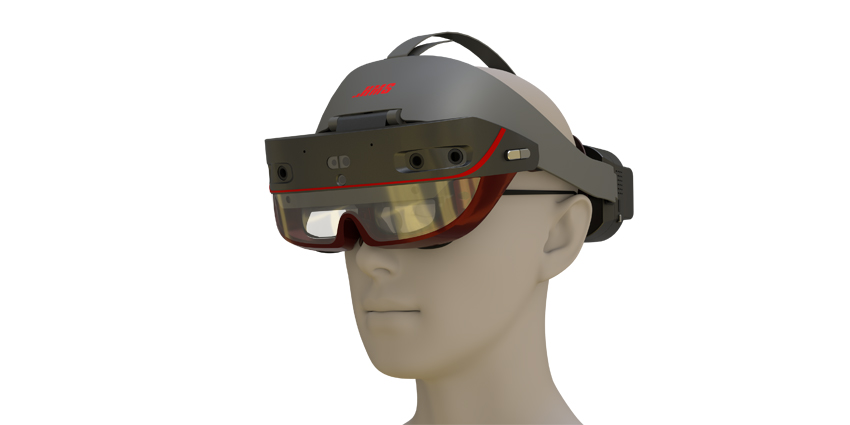Today, Chinese AR smart glasses manufacturer Xreal debuted Apple Macbook integration for its Nebula operating system (OS), significantly improving productivity opportunities for the firm’s Air and Light product lineup. The firm first introduced the Macbook service as a Beta in November 2022.
Nebula for Mac allows users to connect an Xreal product to a Macbook computer to stream immersive content up to 102 inches in size on immersive screens. The Macbook integration enables Apple users to enhance productivity using virtual screens as second monitors via Xreal brand immersive hardware.
By operating a MacBook computer with Xreal Air devices, users could leverage the Nebula infrastructure to turn their MacBook into an AR-ready mobile workstation – similar to Apple’s recently unveiled spatial computing vision.
Xreal users can access traditional workplace tools such as the Office Suite via their MacBook and stream the service on a virtual monitor at a 1920×1080 resolution and 60Hz refresh rate. Additionally, users can stream media to the glasses’ virtual screen via applications like YouTube and Netflix.
Peng Jin, the Co-Founder at XREAL, added:
Wherever you are, at work or play, your MacBook just became one of the first computers to support enhanced AR and Spatial Computing. I believe that XREAL and Apple share the same vision of Spatial Computing and the enormous impact it will have on our lives. We have worked hard for several years to develop products like XREAL Beam, products that bring us closer to making Spatial Computing a reality
Following its beta release, Xreal’s Nebula OS comes with a collection of new features allowing MacBook users to get a spatial computing experience today – ahead of the Vision Pro’s pricey debut in 2024.
Nebula for Mac Debuts
Nebula for Mac allows users to leverage Xreal smart glasses to expand their workspace across virtual monitors. Hybrid or remote workers can use Xreal expanded workflows to access a multi-monitor mobile workstation.
“Spatial Cinema” abilities allow users to enjoy media experiences on the go. Xreal has a storied history of developing immersive media solutions, with the firm’s Air and Light products being commonly touted as entertainment solutions. The firm has also produced tools for enjoying immersive entertainment on the go in collaboration with Nio.
Peng Jin also added:
Spatial Cinema is part of an initiative at XREAL where employees are encouraged to express their creativity through building their own AR apps. These are not officially supported products from XREAL, but depending on market and community feedback, we may change our minds. Moving forward, we will continue to share similar creative app projects from time to time with the community. The first out of the cage is Spatial Cinema. Compatible with Intel and Apple platforms, we encourage all MacBook users to give it a go.
Sightful Partnership
During this year’s AWE event, Xreal confirmed its rebranding and new technology rumours, with a deep commitment to AR productivity tools, running in annother interesting parallel to Apple’s immersive hardware journey.
Most notably, Xreal introduced a new product called Spacetop. Spacetop is a laptop that works with Xreal AR glasses to provide users with a more immersive computing experience.
The Spacetop laptop is the “first of its kind” and marks a new direction for Xreal. The company has traditionally focused on developing AR glasses for entertainment purposes, but Spacetop is for productivity.
Sightful’s software allows users to interact with the virtual screen in various ways. For example, users can use hand gestures to control the cursor or their voice to dictate commands.
Spacetop is still in the early stages of development, but it can potentially revolutionize how we work. The product’s ability to work with a virtual screen that can be placed anywhere in your field of view could make it easier to multitask and stay organized.
While observers didn’t realize it at the time, the Xreal/Sightful Spacetop is incredibly similar to Apple’s Vision Pro and spatial computing roadmap. Just days after the Sapetop announcement, Apple revealed its Vision Pro product which looks remarkably similar to the Sapcetop offering. However, Apple’s product is both regionally and economically restrictive for many audiences, a fact Xreal is leveraging in its marketing.
Xreal believes that Spacetop is the “first 100M AR killer use case,” meaning that it could be the first AR product to gain a user base of 100 million people. Also, Apple most likely agrees that its own spatial computing vision will transform consumer adoption rates.
Xreal Rebranding
This year, Nreal rebranded as Xreal. The move came following the Chinese firm facing serious, multi-year legal troubles with Epic Games, who took Xreal to court over the use of similarly titled services.
Epic claimed that the two companies trademarks, “Nreal” and “Unreal,” were visually similar and could create confusion among customers. Epic also argued that the two companies worked with the same technology partners, which could further increase the likelihood of confusion.
Xreal argued that its trademark was sufficiently distinctive and different from Epic’s trademark. Xreal also said that its shared technology partners were sophisticated enough to notice the difference between the two companies.
The legal battle between Epic and Xreal lasted for several years. In 2019, the two companies agreed to a 60-day negotiation period. However, in 2022, Xreal filed a countersuit against Epic, requesting that Epic pay Xreal’s court fees.
With Epic’s continued dedication to XR in more recent years, the firm’s initial filling makes increased sense in 2023 because, in 2019, the firm was still focusing on gaming.
Earlier this year, rumours emerged showing an Xreal Federal Communications Commission patent filing for an “Xreal Beam” device – a successor to the “Nreal” Streaming Box.
Additional AWE Annoucements
Moreover, at AWE, Xreal also announced a version of its Nebula SDK for Steam Deck users. The Nebula SDK is a software development kit that allows developers to create AR experiences for Xreal’s AR glasses. The Steam Deck is a handheld gaming console popular among AR users.
Xreal also introduced the rumoured Beam attachment, which can control Xreal’s AR glasses without a mobile phone. The Beam attachment connects to the glasses wirelessly or with a wire, providing several features, including 3DoF tracking, smooth following, and adjustable virtual screen sizes.
Massive Demand for Xreal on Apple Devices
The update follows Xreal Nebula’s successful launch on Apple’s iOS for iPhone 14 in September 2022. The combined technology opportunity led to a massive demand from the shared audience of Xreal and Apple.
Xreal first teased the iPhone integration after Apple announced the iPhone 14 and 14 Pro in early September of that year. The update enables Apple iPhone users to access immersive media streaming applications through their mobile devices with 5G integration.
In late September 2022, the Chinese firm debuted preorders for the Apple dongle on Amazon for $59 as part of an extended deal with the online marketplace to distribute the Xreal Air device on its Prime service for US customers.
The deal attracted considerable attention from Apple fans, and the Xreal Apple dongle sold-out within 24 hours of debuting on the Amazon marketplace.
At the time, the sell-out adaptors showed a demand for Apple support on Xreal – then Nreal – products. However, it appears that the two firms may align closely as competitors, and Xreal’s pre-existing presence in the iOS ecosystem could create an interesting story as each firm’s roadmap advances.
Direct Competition to Apple’s Vision Pro
Xreal’s iOS integration focus comes alongside Apple’s marketplace debut.
The long-awaited hardware debut came during Apple’s WWDC showcase, which introduced the Apple Vision Pro after years of speculation.
Apple surprised audiences watching home and in person with a massive $3499 price and enterprise focus.
The device uses spatial computing to create a 360 immersive environment that allows users to interact with conventional and immersive applications using body gestures – similar to Spacetop.
The Vision Pro OS leverages three core design concepts to secure its spatial computing vision: Windows, Volumes, and Spaces. Windows represent the 2D user interface, while volumes are RT3D immersive experiences. Finally, Spaces are the spatial computing environment in which volumes and applications exist.
Moreover, the device contains competitive features such as a custom M2 Silicon chip, Apple’s purpose-built R1 graphics processor, 23 million pixel display across two huge micro-OLED lenses, enabling a total display resolution of 4096 x 5464 pixels, high-dynamic range (HDR), wide colour gamut (WCG) outputs, 2-hour battery life, an immersive camera for capturing spatial audio/photos/video for peer-to-peer sharing, iPhone/iPad/Mac synchronization, a light seal, a LiDAR scanner, and a TrueDepth camera.
Apple VS. Xreal?
Apple’s immersive OS is visually very similar to the Spacetop product offering. However, neither is widely available to consumers, so audiences are undecided on spatial computing opportunities from either company.
Although, XR content developers can become familiar with each OS before jumping into the hardware. Just recently, Apple made the Vision Pro OS available to international developers to help familiarise them with the system, allowing developers to create new or port pre-existing services to the upcoming device.
Additionally, in a survey conducted by Streetbees, 50 percent of questioned individuals aware of the Vision Pro are excited about the device, and a further 27 percent intend to buy it. The StreetBee study also found that Vision Pro’s price point leads to 54 percent not wishing to purchase the product.
The numbers could suggest a sizeable swingable consumer base that is interested in spatial computing but also deterred by Apple distribution methods – this may give Xreal a perfect chance to swoop in as a serious spatial computing player and Apple competitor.








